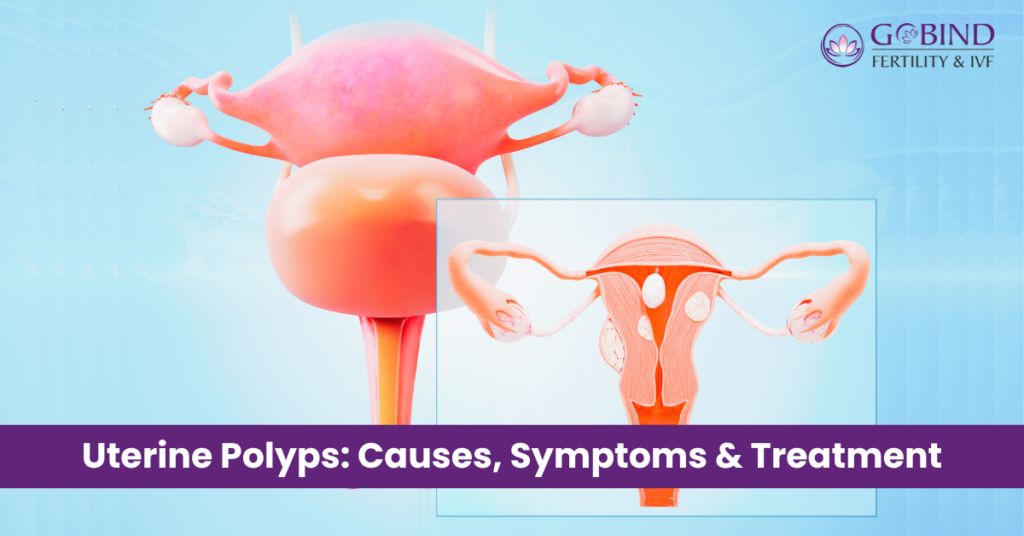Uterine Polyps: Causes, Symptoms & Treatment

Uterine polyps, also known as endometrial polyps, are growths arising from the inner wall of the uterus that extend into the uterine cavity. They are made up of endometrial tissue lining the uterus and are typically benign (non-cancerous). However, they can cause various symptoms and may sometimes necessitate medical treatment. This article delves into the causes, symptoms, and treatments for uterine polyps.
Causes of Uterine Polyps
The exact cause of uterine polyps is not well understood, but several factors are believed to contribute to their development:
1. Hormonal Factors: Uterine polyps are estrogen-sensitive, which means they grow in response to estrogen. This hormone is crucial for the thickening of the endometrial lining during the menstrual cycle. An imbalance or excess of estrogen can lead to the overgrowth of endometrial tissue, resulting in polyps.
2. Age: Uterine polyps are most common in women who are in their 40s and 50s, which correlates with the years leading up to menopause and early post-menopause when hormonal fluctuations are significant.
3. Obesity: Higher levels of estrogen are found in obese women, which may increase the risk of developing uterine polyps.
4. Hypertension: Some studies suggest a link between high blood pressure and the development of uterine polyps.
5. Hormonal Medications: Certain medications, such as tamoxifen, a drug used to treat breast cancer, can have estrogen-like effects on the uterus, potentially leading to the growth of polyps.
6. Genetic Factors: A familial tendency towards the formation of uterine polyps can also play a role, although this is less well-established compared to other factors.
Symptoms of Uterine Polyps
Uterine polyps can vary greatly in size and number, and not all women with polyps will experience symptoms. When symptoms do occur, they can include:
1. Irregular Menstrual Bleeding: This is the most common symptom. Women may experience heavy periods (menorrhagia), bleeding between periods (metrorrhagia), or an irregular menstrual cycle.
2. Postmenopausal Bleeding: Any vaginal bleeding after menopause is a potential symptom of uterine polyps and should be evaluated by a healthcare provider like Dr Manju Khurana, having more than 25 years of experience.
3. Infertility: Uterine polyps can interfere with fertility by blocking the fallopian tubes or preventing a fertilized egg from implanting in the uterus.
4. Pain and Discomfort: Some women may experience pelvic pain or discomfort, especially if the polyp is large.
5. Vaginal Discharge: In some cases, there may be an increase in vaginal discharge.
Diagnosis of Uterine Polyps
Diagnosing uterine polyps typically involves a combination of clinical evaluation and imaging techniques:
1. Transvaginal Ultrasound: This is often the first step in diagnosing uterine polyps. A transvaginal ultrasound involves inserting an ultrasound probe into the vagina to get detailed images of the uterus and detect any abnormalities.
2. Hysteroscopy: This procedure involves inserting a thin, lighted telescope (hysteroscope) through the vagina and cervix into the uterus. It allows the doctor to view the inside of the uterus directly and is often used to confirm the presence of polyps and assess their size and location.
3. Endometrial Biopsy: A sample of the endometrial tissue may be taken and examined under a microscope to rule out cancer or other abnormalities.
4. Sonohysterography: This is a special kind of ultrasound where saline is injected into the uterus to expand the uterine cavity, providing a clearer view of the endometrial cavity.
Treatment of Uterine Polyps
The treatment for uterine polyps depends on the size of the polyps, the severity of the symptoms, and whether the woman is at risk for uterine cancer. Treatment options include:
1. Watchful Waiting: Small, asymptomatic polyps may not require immediate treatment. Regular monitoring with periodic ultrasounds may be recommended to ensure that they are not growing or causing problems.
2. Medications: Hormonal medications, such as progestins or gonadotropin-releasing hormone agonists, can help shrink polyps and alleviate symptoms, but these are generally considered temporary solutions as polyps often return once the medication is stopped.
3. Surgical Removal: Polyps causing significant symptoms or those found in women at risk of uterine cancer are often removed surgically. Common procedures include:
– Hysteroscopic Polypectomy: This minimally invasive procedure is the most common way to remove polyps. A hysteroscope is inserted through the vagina and cervix into the uterus, allowing the doctor to see and remove the polyps using specialized instruments.
– Dilation and Curettage (D&C): This involves dilating the cervix and scraping the uterine lining to remove polyps. This can be done alone or in combination with hysteroscopy.
4. Hysterectomy: In rare cases where polyps are recurrent, large, or associated with cancer and family is complete, removal of the uterus (hysterectomy) may be recommended.
Preventing Uterine Polyps
While there is no sure way to prevent uterine polyps, certain lifestyle and medical strategies may reduce the risk:
1. Regular Check-ups: Routine gynaecological exams can help detect uterine polyps early, especially in women with risk factors.
2. Managing Weight: Maintaining a healthy weight can help regulate hormone levels and reduce the risk of developing polyps.
3. Controlling Blood Pressure: Managing hypertension through lifestyle changes and medication may decrease the risk.
4. Medication Review: Women taking medications like tamoxifen should discuss their risks with their healthcare provider and have regular monitoring for uterine abnormalities.
Conclusion
Uterine polyps are a common gynaecological issue that can cause a range of symptoms, from irregular bleeding to infertility. Understanding the potential causes and symptoms can help in early detection and treatment. While most polyps are benign, timely intervention is crucial to prevent complications, including the potential for malignancy.
Women experiencing any unusual symptoms should consult their gynaecologist for appropriate evaluation and management. In Hisar, if you are searching for the best gynaecologist in Haryana, Consult Dr Manju Khurana at Gobind Fertility & IVF Centre in Hisar.
